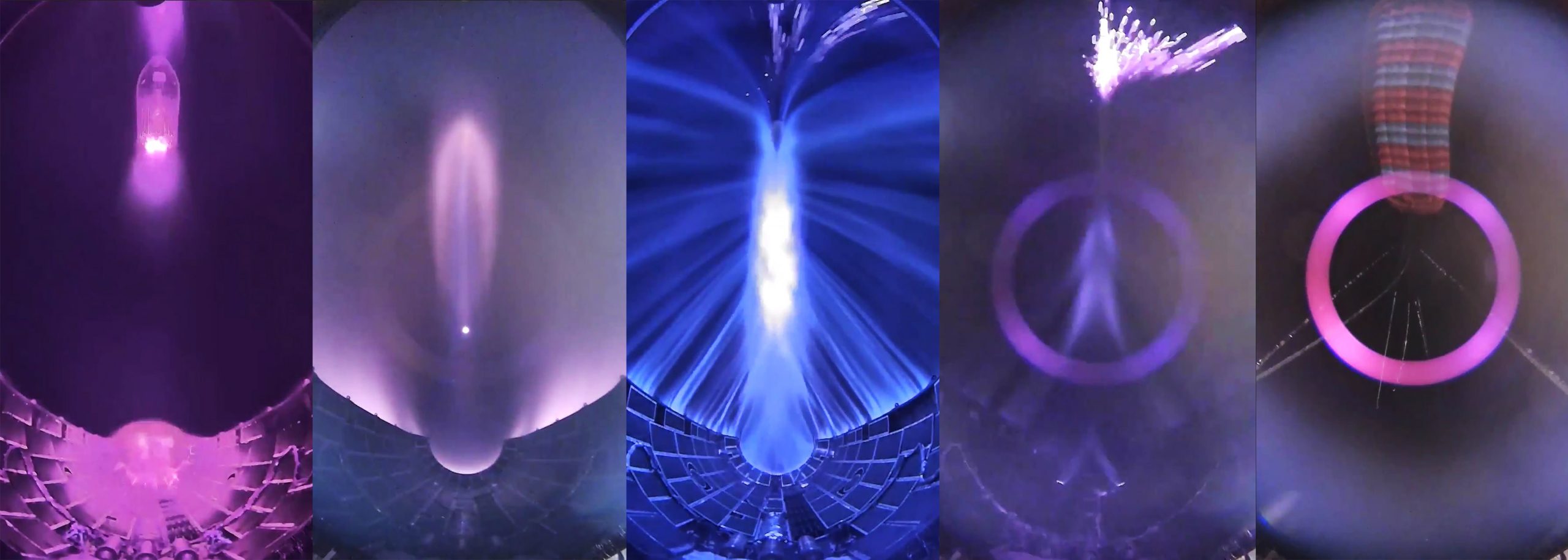
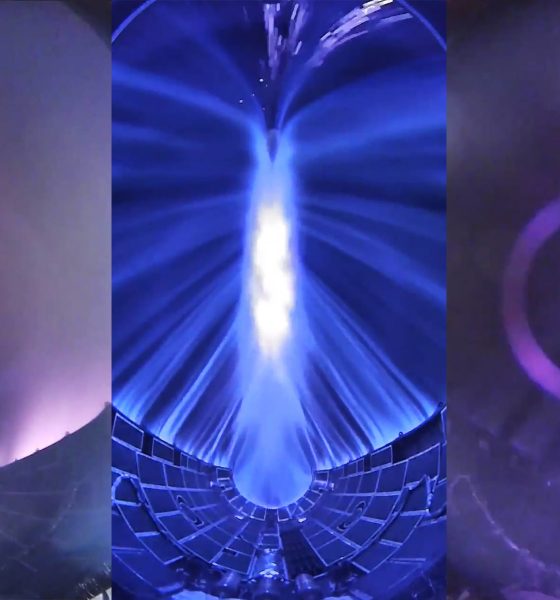
News
SpaceX’s Falcon Heavy fairing tries to enter hyperspace, lands in net in new videos
SpaceX and CEO Elon Musk have released videos offering an extended look at the unexpectedly dramatic conditions Falcon payload fairings are subjected to during atmospheric reentry, as well as the first successful landing in GO Ms. Tree’s net.
Captured via an onboard GoPro camera during Falcon Heavy’s June 25th launch of the USAF Space Test Program-2 (STP-2) mission, the minute-long cut shows off a light show more indicative of a spacecraft entering hyperspace than the slightly more mundane reality. Shortly after SpaceX posted the reentry video, CEO Elon Musk followed up with a video showing a fairing’s gentle landing in Ms. Tree’s net. More likely than not, the fairing with the camera attached and the fairing that became the first to successfully land in Mr. Steven’s (now GO Ms. Tree’s) net are the same half. Regardless, the videos help document a major step forward towards SpaceX’s ultimate goal of fairing reuse.
“In a pleasant, last-minute surprise, SpaceX fairing recovery vessel Mr. Steven has departed Port Canaveral for its first Falcon fairing catch attempt in more than half a year. The speedy ship has already traveled more than 1250 km (800 mi) in ~48 hours and should soon be in position to attempt recovery of Falcon Heavy Flight 3’s payload fairing halves.
Over the last week or two, Mr. Steven has been officially renamed to GO Ms. Tree, a strong indicator that Guice Offshore (GO) – a company SpaceX is heavily involved with – has acquired the vessel from financially troubled owner/operator Sea-Tran Marine. With this likely acquisition, nearly all of SpaceX’s non-drone ship vessels are now leased from – and partially operated by – GO. The name change is undeniably bittersweet for those that have been following Mr. Steven’s fairing recovery journey from the beginning. However, it’s also more than a little fitting given that the vessel switched coasts and suffered an accident that forced SpaceX to replace the entirety of its arm-boom-net assembly. Much of Mr. Steven – now GO Ms. Tree – has been replaced in the last few months and with any luck, the vessel is better equipped than ever before to snag its first Falcon fairing(s) out of the air.”
— Teslarati.com, June 24th
As they say, the rest is history. Some 60-75 minutes after Falcon Heavy lifted off from Pad 39A on June 25th, Ms. Tree successfully caught a parasailing fairing for the first time ever, just barely snagging one of the two halves at the very edge of the ship’s net. Two days later, Ms. Tree arrived back at Port Canaveral. Another 24 hours after that, the intact, dry fairing half was safely lifted onto land and transported to a local SpaceX facility dedicated to analyzing (and eventually refurbishing) recovered Falcon fairings.
Landing on Ms. Tree pic.twitter.com/4lhPWRpaS9— Elon Musk (@elonmusk) July 4, 2019
With any luck, the successful catch will prove that the years of work have been worth it, demonstrating that fairing halves caught – rather than fished out of the ocean – are structurally sound and clean enough to be quickly and affordably reused. While Falcon fairings have been estimated to take up less than 10% of the material cost of Falcon 9 production (~$6M, $3M/half), the manufacturing apparatus needed to build them takes up a huge amount of space. Additionally, the process of oven-curing huge, monolithic carbon fiber fairings introduces fundamental constraints that physically limit how quickly they can be built.
Fairing reuse would be an invaluable benefit for SpaceX’s internal Starlink launches, of which dozens and – eventually – hundreds will be needed to build an operational constellation of satellites. Thanks to the wonders of Falcon 9 Block 5 booster reuse, the internal cost of a flight-proven booster is essentially just the cost of refurbishment and then the propellant and work-hours needed to launch it. What remains is the cost of the expendable Falcon upper stage (unlikely to be recovered or reused) and payload fairing, now reasonably consistent at landing intact on the ocean surface but yet to demonstrate practical reusability.
As proposed, SpaceX’s completed Starlink constellation represents almost 12,000 satellites. Assuming no progress is made with packing density, no larger payload fairing is developed, and Starship doesn’t reach orbit until the mid-2020s (admittedly unlikely), Starlink will require almost exactly 200 Falcon 9 launches, each carrying 60 satellites. According to Musk, despite the fact that the first 60 satellites launched were effectively advanced prototypes, the cost of launch is already more than the cost of satellite production.
Speaking at a conference in 2017, Musk noted that payload fairings cost about $6M to produce, roughly 10% of Falcon 9’s $62M list price. In 2013, Musk stated that the first stage represented less than 75% of the overall cost of Falcon 9 production, meaning that the rocket’s upper stage probably represents another 15-20% (call it a 70:20:10 split), or ~$9-12M. Conservatively assuming that the operating costs of Falcon 9 refurbishment, launch, and recovery are roughly $5M per mission, the internal cost to SpaceX for a launch with a recoverable flight-proven booster and an expended fairing and upper stage could be just $20-25M and may be even lower.


For reference, assuming 200 Falcon 9 launches, SpaceX could save nearly $600M by consistently recovering and reusing just one fairing half on average per launch, up to as much as $1.2B if both halves can be consistently recovered and reused. June 25th’s successful fairing catch is the biggest step yet in that direction and is hopefully a sign of many good things to come for SpaceX’s latest attempt at building truly reusable rockets.
Check out Teslarati’s Marketplace! We offer Tesla accessories, including for the Tesla Cybertruck and Tesla Model 3.

News
Tesla earns top honors at MotorTrend’s SDV Innovator Awards
MotorTrend’s SDV Awards were presented during CES 2026 in Las Vegas.

Tesla emerged as one of the most recognized automakers at MotorTrend’s 2026 Software-Defined Vehicle (SDV) Innovator Awards.
As could be seen in a press release from the publication, two key Tesla employees were honored for their work on AI, autonomy, and vehicle software. MotorTrend’s SDV Awards were presented during CES 2026 in Las Vegas.
Tesla leaders and engineers recognized
The fourth annual SDV Innovator Awards celebrate pioneers and experts who are pushing the automotive industry deeper into software-driven development. Among the most notable honorees for this year was Ashok Elluswamy, Tesla’s Vice President of AI Software, who received a Pioneer Award for his role in advancing artificial intelligence and autonomy across the company’s vehicle lineup.
Tesla also secured recognition in the Expert category, with Lawson Fulton, a staff Autopilot machine learning engineer, honored for his contributions to Tesla’s driver-assistance and autonomous systems.
Tesla’s software-first strategy
While automakers like General Motors, Ford, and Rivian also received recognition, Tesla’s multiple awards stood out given the company’s outsized role in popularizing software-defined vehicles over the past decade. From frequent OTA updates to its data-driven approach to autonomy, Tesla has consistently treated vehicles as evolving software platforms rather than static products.
This has made Tesla’s vehicles very unique in their respective sectors, as they are arguably the only cars that objectively get better over time. This is especially true for vehicles that are loaded with the company’s Full Self-Driving system, which are getting progressively more intelligent and autonomous over time. The majority of Tesla’s updates to its vehicles are free as well, which is very much appreciated by customers worldwide.
Elon Musk
Judge clears path for Elon Musk’s OpenAI lawsuit to go before a jury
The decision maintains Musk’s claims that OpenAI’s shift toward a for-profit structure violated early assurances made to him as a co-founder.

A U.S. judge has ruled that Elon Musk’s lawsuit accusing OpenAI of abandoning its founding nonprofit mission can proceed to a jury trial.
The decision maintains Musk’s claims that OpenAI’s shift toward a for-profit structure violated early assurances made to him as a co-founder. These claims are directly opposed by OpenAI.
Judge says disputed facts warrant a trial
At a hearing in Oakland, U.S. District Judge Yvonne Gonzalez Rogers stated that there was “plenty of evidence” suggesting that OpenAI leaders had promised that the organization’s original nonprofit structure would be maintained. She ruled that those disputed facts should be evaluated by a jury at a trial in March rather than decided by the court at this stage, as noted in a Reuters report.
Musk helped co-found OpenAI in 2015 but left the organization in 2018. In his lawsuit, he argued that he contributed roughly $38 million, or about 60% of OpenAI’s early funding, based on assurances that the company would remain a nonprofit dedicated to the public benefit. He is seeking unspecified monetary damages tied to what he describes as “ill-gotten gains.”
OpenAI, however, has repeatedly rejected Musk’s allegations. The company has stated that Musk’s claims were baseless and part of a pattern of harassment.
Rivalries and Microsoft ties
The case unfolds against the backdrop of intensifying competition in generative artificial intelligence. Musk now runs xAI, whose Grok chatbot competes directly with OpenAI’s flagship ChatGPT. OpenAI has argued that Musk is a frustrated commercial rival who is simply attempting to slow down a market leader.
The lawsuit also names Microsoft as a defendant, citing its multibillion-dollar partnerships with OpenAI. Microsoft has urged the court to dismiss the claims against it, arguing there is no evidence it aided or abetted any alleged misconduct. Lawyers for OpenAI have also pushed for the case to be thrown out, claiming that Musk failed to show sufficient factual basis for claims such as fraud and breach of contract.
Judge Gonzalez Rogers, however, declined to end the case at this stage, noting that a jury would also need to consider whether Musk filed the lawsuit within the applicable statute of limitations. Still, the dispute between Elon Musk and OpenAI is now headed for a high-profile jury trial in the coming months.
News
Tesla Giga Shanghai celebrates 5 million electric drive unit milestone
The milestone was celebrated by the company in a post on its official Weibo account.
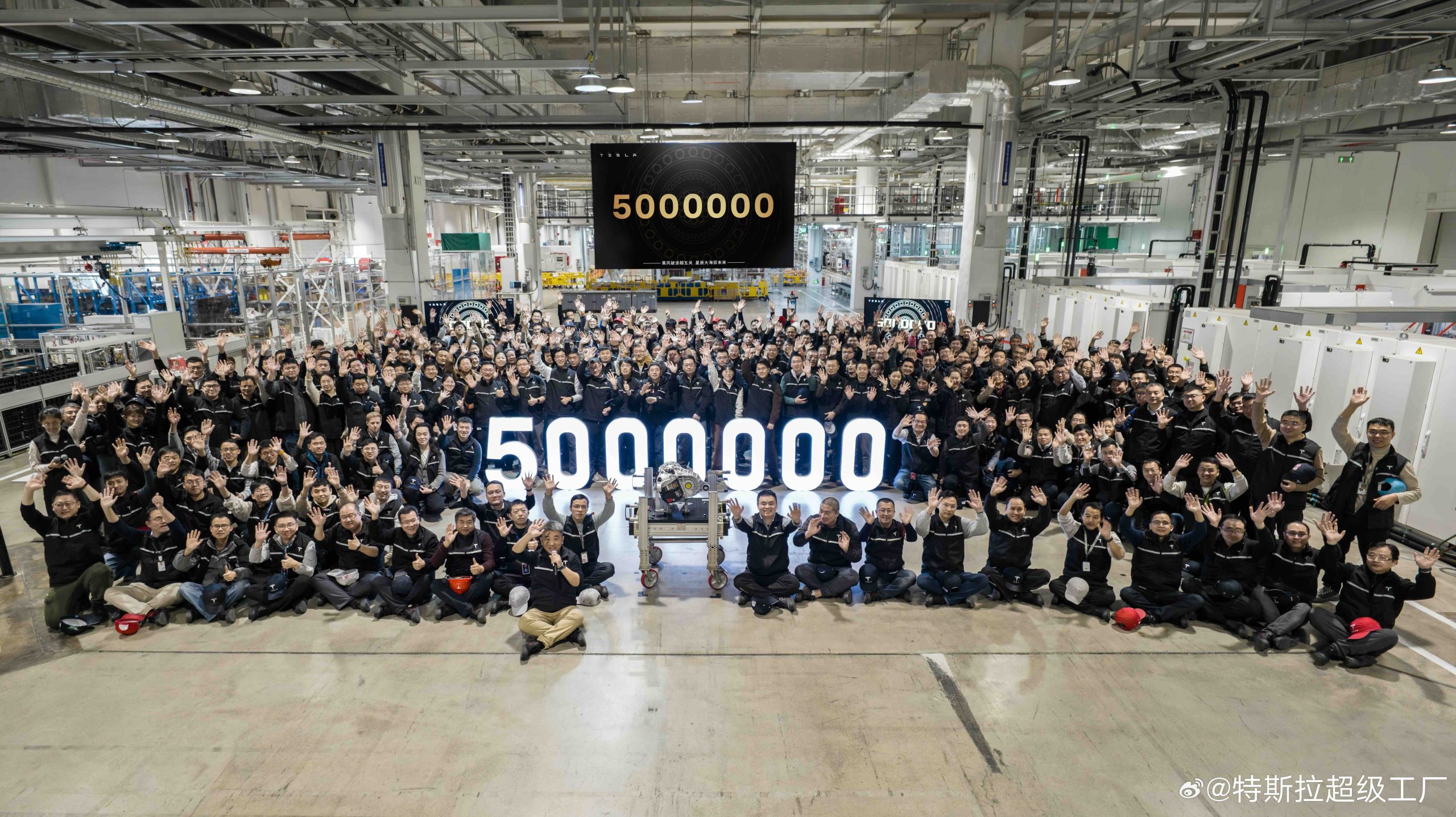
Tesla China has reached another manufacturing milestone at Gigafactory Shanghai, rolling out the facility’s 5 millionth locally produced drive unit.
The milestone was celebrated by the company in a post on its official Weibo account. In its post, the Giga Shanghai team could be seen posing with the 5 millionth drive unit.
Giga Shanghai’s major benchmark
The milestone drive unit was produced at Gigafactory Shanghai, which produces the Model Y and the Model 3. In a release, Tesla China noted that its three-in-one integrated electric drive system combines the motor, gearbox, and inverter into a single compact assembly. This forms a powerful “heart” for the company’s electric cars.
Tesla China also noted that its drive units’ integrated design improves energy conversion efficiency while reducing overall weight and complexity, benefits that translate into stronger performance, improved handling, and longer service life for its vehicles.
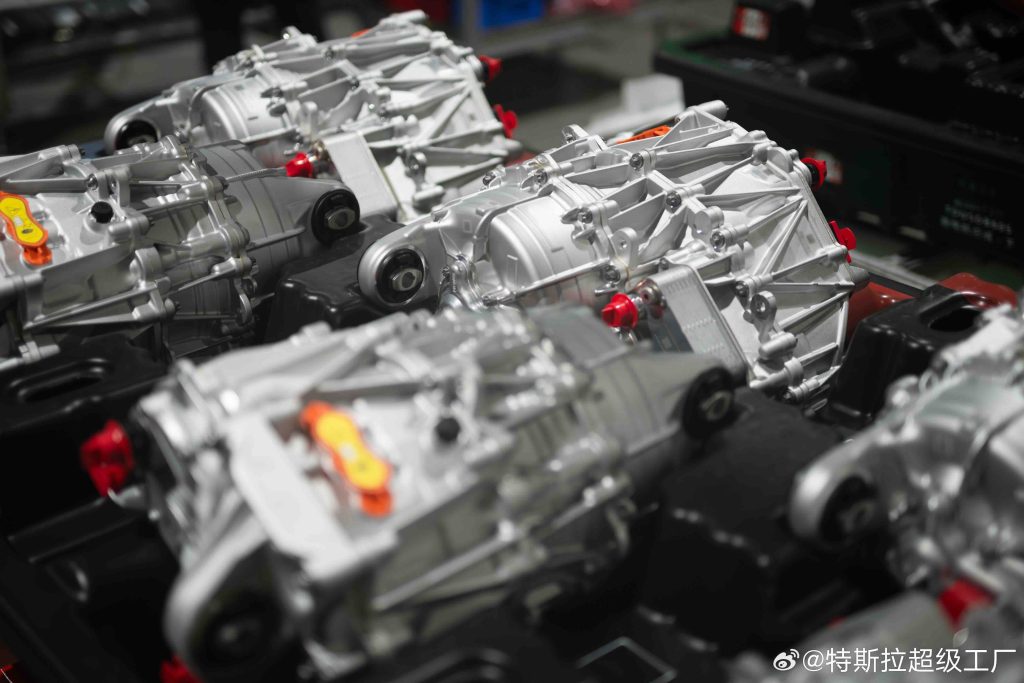
The new milestone builds on earlier achievements at the same site. In July 2024, Tesla announced that its 10 millionth electric drive system globally had rolled off the line at the Shanghai plant, making it the first self-produced Tesla component to reach that volume.
More recently, the factory also produced its 4 millionth China-made vehicle, a Model Y L. The factory has also continued hitting global production milestones, rolling out Tesla’s 9 millionth EV worldwide late last year, with the landmark vehicle being a Tesla Model Y.
Tesla China’s role
Construction of Giga Shanghai began in January 2019, with production starting by the end of that year. This made it the first wholly foreign-owned automotive manufacturing project in China. The facility began delivering Model 3 vehicles locally in early 2020 and added Model Y production in 2021. The plant is now capable of producing about 1 million vehicles annually.
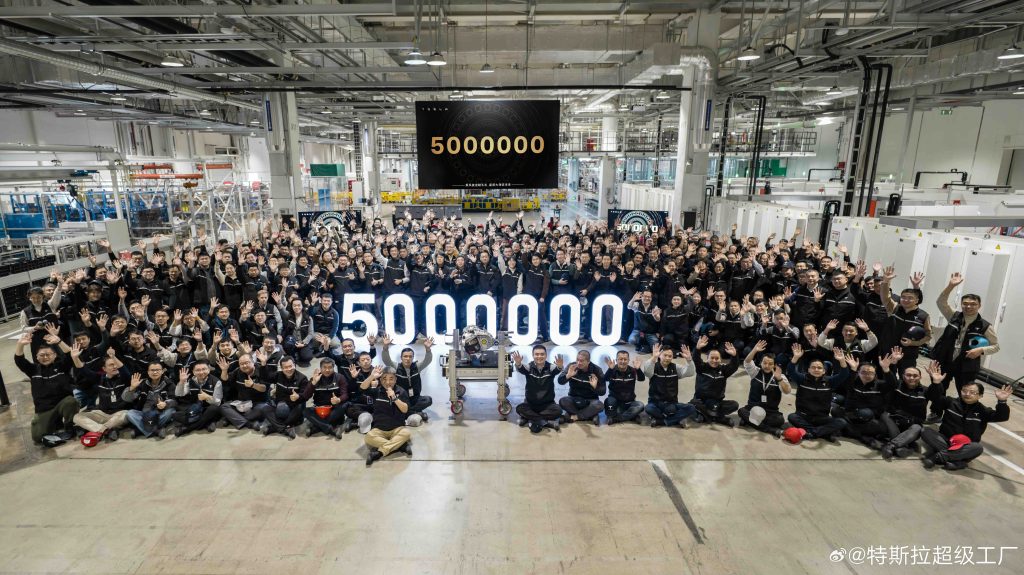
Throughout 2025, Giga Shanghai delivered 851,732 vehicles, representing a 7.08% year-on-year decline, according to data compiled by CNEVPost. Even so, recent months showed renewed momentum.
In December alone, Tesla China recorded wholesale sales of 97,171 vehicles, including domestic deliveries and exports, making it the company’s second-best monthly total on record, per data from the China Passenger Car Association. Retail sales during December reached roughly 94,000 units, up about 13% year over year.








